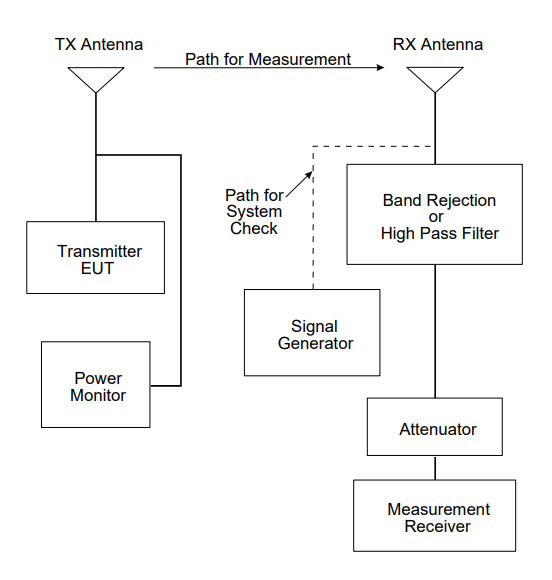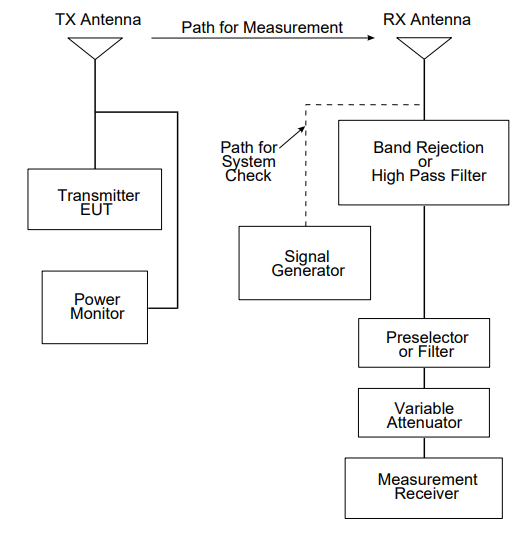
MIL
MIL-STD-461G RE103: Radiated Emissions, Antenna Outputs
Standard Overview
MIL-STD-461G RE103 may be used as an alternative for CE106 when testing transmitters with their intended antennas. This requirement is met if the emissions do not exceed the applicable RE102 limit in transmit mode. MIL-STD-461G RE103 is the preferred requirement unless the equipment or subsystem design characteristics preclude its use. RE103 should be the preferred method for systems using an active antenna or when the antenna impedance has a non-standard impedance curve. The requirement is applicable from 10 kHz to 40 GHz and not applicable within the bandwidth of the EUT transmitted signal or within ±5 percent of the fundamental frequency, whichever is larger. For Navy shipboard applications with peak transmitter power (PtPk) greater than 1 kW, the 5% frequency exclusion is increased by an additional 0.1% of the fundamental frequency for each dB above 1 kW of peak power.
Frequency Exclusion = ±f * (0.05 + (0.001/dB) * (PtPk [dBm] – 60 [dBm]))
According to MIL-STD-461G RE103, the equipment will be tested to an upper-frequency limit based on the highest frequency generated or received by the EUT. For systems with the frequencies generated or received less than 1 GHz, the upper-frequency limit will be 20 times the highest frequency or 18 GHz whichever is greater. For systems with frequencies generated or received greater than or equal to 1 GHz, the upper-frequency limit will be 10 times the highest frequency or 40 GHz whichever is less. For equipment using waveguide, the requirement does not apply below eight-tenths of the waveguide's cutoff frequency.
This test procedure is used to verify that radiated spurious and harmonic emissions from transmitters do not exceed the specified requirements.

FIGURE RE103-2. Measurement system integrity check and test setup for radiated harmonics and spurious emissions, 1 GHz to 40 GHz.

Download Standard
Frequency Exclusion = ±f * (0.05 + (0.001/dB) * (PtPk [dBm] – 60 [dBm]))
| Operating Frequency Range (EUT) | Start Frequency of Test |
|---|---|
| 10 kHz to 3 MHz | 10 kHz |
| 3 MHz to 300 MHz | 100 kHz |
| 300 MHz to 3 GHz | 1 MHz |
| 3 GHz to 40 GHz | 10 MHz |
According to MIL-STD-461G RE103, the equipment will be tested to an upper-frequency limit based on the highest frequency generated or received by the EUT. For systems with the frequencies generated or received less than 1 GHz, the upper-frequency limit will be 20 times the highest frequency or 18 GHz whichever is greater. For systems with frequencies generated or received greater than or equal to 1 GHz, the upper-frequency limit will be 10 times the highest frequency or 40 GHz whichever is less. For equipment using waveguide, the requirement does not apply below eight-tenths of the waveguide's cutoff frequency.
This test procedure is used to verify that radiated spurious and harmonic emissions from transmitters do not exceed the specified requirements.
Test Equipment
The test equipment shall be as follows:- Measurement receiver
- Attenuators, 50 ohm
- Antennas
- Rejection networks
- Signal generators
- Power monitor
Procedures
The test procedures shall be as follows:- a. The measurements must be performed in the far-field of the transmitting frequency. Consequently, the far-field test distance must be calculated prior to performing the test using the relationships below:
- R = distance between the transmitter antenna and the receiver antenna.
- D = maximum physical dimension of the transmitter antenna.
- d = maximum physical dimension of the receiver antenna.
- λ = wavelength of the frequency of the transmitter.
- All dimensions are in meters.
- For transmitter frequencies less than or equal to 1.24 GHz, the greater distance of the following relationships shall be used:
- R = 2D2 /λ R = 3λ
- For transmitter frequencies greater than 1.24 GHz, the separation distance shall be calculated as follows:
- For 2.5 D < d use R = 2D2 /λ
- For 2.5 D λ d use R = (D+d)2 /λ
- b. Turn on the measurement equipment and allow sufficient time for stabilization.
- c. Measurement system integrity check.
- (1) Apply a known calibrated signal level from the signal generator through the system check path at a mid-band fundamental frequency (fo).
- (2) Scan the measurement receiver in the same manner as a normal data scan. Verify the measurement receiver detects a level within ±3 dB of the expected signal.
- (3) If readings are obtained which deviate by more than ±3 dB, locate the source of the error and correct the deficiency prior to proceeding with the test.
- (4) Repeat 5.19.3.4c(1) through 5.19.3.4c(3) for two other frequencies over the frequency range of the test.
- d. EUT testing.
- (1) Turn on the EUT and allow a sufficient time for stabilization.
- (2) Tune the EUT to the desired test frequency and use the measurement path to complete the rest of this procedure.
- (3) Tune the test equipment to the measurement frequency (fo) of the EUT and adjust for maximum indication.
- (4) For transmitters where a power monitor can be inserted, measure the modulated transmitter power output P, using a power monitor while keying the transmitter. Convert this power level to units of dB relative to 1 watt (dBW). Calculate the Effective Radiated Power (ERP) by adding the EUT antenna gain to this value. Record the resulting level for comparison with that obtained in 5.19.3.4d(6).
- (5) Key the transmitter with the desired modulation. Tune the measurement receiver for maximum output indication at the transmitted frequency. If either or both of the antennas have directivity, align both in elevation and azimuth for maximum indication. Verbal communication between sites via radiotelephone will facilitate this process. Record the resulting maximum receiver meter reading and the measurement receiver bandwidth.
- (6) Calculate the transmitter ERP in dBW, based on the receiver meter reading V, using the following equation: ERP = V + 20 log R + AF - 135 where:
- V = reading on the measurement receiver in dBμV
- R = distance between transmitter and receiver antennas in meters
- AF = antenna factor of receiver antenna in dB (1/m)
- Compare this calculated level to the measured level recorded in 5.19.3.4d(4). The compared results should agree within ±3 dB. If the difference exceeds ±3 dB, check the test setup for errors in measurement distance, amplitude calibration, power monitoring of the transmitter, frequency tuning or drift and antenna boresight alignment. Assuming that the results are within the ±3 dB tolerance, the ERP becomes the reference for which amplitudes of spurious and harmonics will be compared to determine compliance with standard limits.
- (7) With the rejection network filter connected and tuned to fo, scan the measurement receiver over the frequency range of test to locate spurious and harmonic transmitted outputs. It may be necessary to move the measuring system antenna in elevation and azimuth at each spurious and harmonic output to assure maximum levels are recorded. Maintain the same measurement receiver bandwidth used to measure the fundamental frequency in 5.19.3.4d(5).
- (8) Verify that spurious outputs are from the EUT and not spurious responses of the measurement system or the test site ambient.
- (9) Calculate the ERP of each spurious output. Include all correction factors for cable loss, amplifier gains, filter loss, and attenuator factors.
- (10) Repeat 5.19.3.4d(2) through 5.19.3.4d(9) for other fo of the EUT.
Test Setup
It is not necessary to maintain the basic test setup for the EUT as shown and described on Figures 1 through 5 and in 4.3.8. The test setup shall be as follows:- a. Measurement system integrity check. Configure the test setup for the signal check path shown in Figure RE103-1 or RE103-2, as applicable.
- b. EUT testing. Configure the test setup for the measurement path shown in Figure RE103-1 or RE103-2, as applicable

FIGURE RE103-2. Measurement system integrity check and test setup for radiated harmonics and spurious emissions, 1 GHz to 40 GHz.

Download Standard


